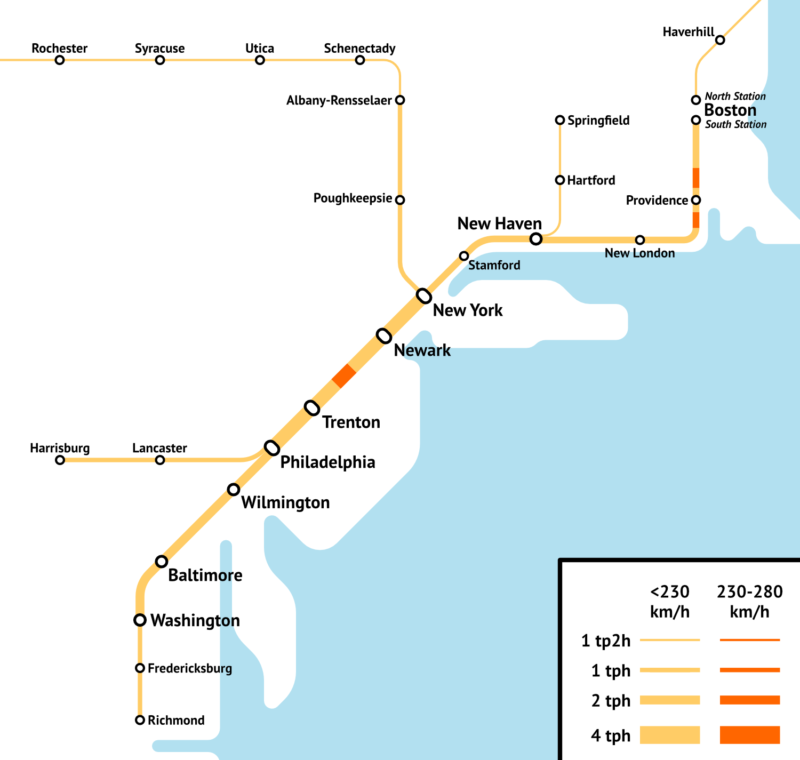SCHEDULING
COORDINATING SCHEDULE PLANNING ACROSS THE NEC
Introduction
The bulk of our work is in developing schedules that allow commuter and intercity trains to share the same tracks productively. For this, we use assumptions on how trains should be timetabled from Germany and surrounding countries, rather than the peak-focused schedules common in the United States. The fundamental principles are,
- Simplicity: we schedule one hour or half hour and repeat it all day.
- Coordination: the same process is used to timetable an entire line, both state-owned commuter railroads and federally-owned Amtrak.
- Reliability-centered design: we target investments at reducing delays, especially reducing propagation of delays between different trains.
Takt Principles
Timetable Padding
Timetables always include buffer time, or padding. This permits trains to recover from delays. More complex and delay-prone timetables require additional padding. In Germany, the buffer time reaches 25% as a single late train can delay much of the rest of the network as trains are held for it, similar to the NEC. In contrast, networks designed around reliability and alleviation of bottlenecks, including Switzerland, the Netherlands, and Sweden, keep the trains on time with just 7% padding. One reason for electrifying and raising the platforms on all commuter lines touching the NEC is to reduce branch delays, which could propagate to the mainline.
How timetable padding increases trip times
One- and two-dimensional networks
Germany, Switzerland, and the Netherlands follow similar timetable and infrastructure design philosophies. So why is Germany notorious for its train delays while Switzerland and the Netherlands are famously punctual? The answer has to do with network complexity. It is fortunate that the NEC has low network complexity, not much more than the Japanese Shinkansen, which is famously punctual with very little padding.


Developing Timetables
In developing the timetable, we used open-source tools to convert train performance calculations into schedules showing where each train is supposed to be at any given second. The simplicity of the NEC—a single line with some branches—allows us to manually adjust exact departure and arrival times to ensure fast trains overtake slow ones where there is room for them to do so. For example, between Boston and Providence, the line is predominantly double-track, with one existing quad-track overtake at Attleboro, and a proposed triple-track overtake between Readville and Route 128.
Scheduling commuter and intercity trains on shared routes
Lines to be timetabled
In writing exact timetables, we look at all commuter lines that use the NEC as well as at NEC intercity service. We don’t generally look at the branch timetables, with the exception of the most important branch: that at New Rochelle to Grand Central, where all New Haven Line trains go today instead of Penn Station, and where most will still go after Metro-North’s Penn Station Access project opens.
| Line | Frequency (peak) | Frequency (off-peak) |
|---|---|---|
| Providence (north of Providence) | 15 | 30 |
| Providence (south of Providence) | 30 | 30 |
| Stoughton | 15 | 30 |
| New Haven express (north of Stamford) | 10 | 20 |
| New Haven express (south of Stamford) | 10 | 10 |
| New Canaan | 20 | 20 (as a shuttle) |
| Danbury | 20 | 20 (as a shuttle) |
| New Haven local (GCT) | 10 | 10 |
| New Haven local (Penn)-NJT express (north of New Rochelle) | 10 | 20 |
| New Haven local (Penn)-NJT express (New Rochelle-Newark) | 10 | 10 |
| New Haven local (Penn)-NJT express (south of Newark) | 10 | 20 |
| NJT NEC local | 10 | 20 |
| North Jersey Coast | 10 | 20 |
| SEPTA Trenton | 20 | 20 |
| SEPTA Wilmington (north of Chester) | 15 | 30 |
| SEPTA Wilmington (south of Chester) | 30 | 30 |
| MARC Penn (north of Baltimore) | 30 | 30 |
| MARC Penn (south of Baltimore) | 15 | 30 |
Headways for peak and off-peak service
The Northeast Corridor is, like the Shinkansen, one-dimensional. Unlike the Shinkansen, nearly the entire corridor is used by commuter trains, often with shared track, requiring the use of German, Dutch, and Swiss techniques to timetable all trains together. While the complexity of the track sharing between commuter and intercity trains is high, the shape of the network is simple.
Germany has a thick two-dimensional network of lines, the most complex in the developed world, with high-traffic spines crisscrossing the country north-to-south and east-to-west. With so many connections and overtakes of faster intercity and slower regional trains, one delay can propagate across the entire network. Thus, the same planning principles that produce Swiss efficiency are less efficient in Germany, which is notorious for its rail delays.